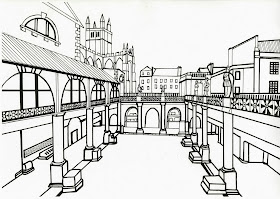The Big Draw evening was a lot of fun. There were lots of activities around the
museum for visitors to enjoy. The group artwork was very popular, it was great
to see so many people colouring it in and enjoying themselves. It’s almost
tempting to re-paint the Great Bath with the new colour scheme. We didn’t quite
get it all finished on the night, but considering how big it is we got a good
way through it.
 |
| The colourful Group Art Work |
One of the most popular demonstrations of the night would
have to have been Chris Evans, a textile design student from Bath Spa
University and volunteer here at the Roman Baths. I don’t think there was
anybody who came along on the night who didn’t stop by his table. He had a
wonderful display of fabric dyes, from the slightly toxic indigo to the little
insects of cochineal, pretty woad and many other raw dyes. He also had fabric
samples and cloth which he’d woven himself. When there weren’t people at his
table, which wasn’t often, he took the chance to continue his work on the
replica Roman loom we have. It’s amazing
to see him work so quickly at something which looks so complicated. He did
explain it all to me, but I haven’t been brave enough to try it.
 |
| Chris and the loom |
Laurence Tindall, a stonemason, had a fantastic
demonstration and activity on painted stone. Some people were even so
enthralled by it that they happily stayed listening to him for most of their time
in the museum. He was particularly popular with people who had visited the
Roman Baths before and were excited to see something new, and hands on, to add
to their museum experience.
 |
| Children having a go at their own art with advice from Laurence. |
Our ‘Drawing the Roman Baths 2100’ postcard competition got
off to a great start. Some of the entries were just wonderful. It was lovely to
see people taking the time to create the best postcard they could for the
competition. Some children even liked their postcards so much that they took
them home to keep rather than give to us.
 |
| Our postcard competition desk |
It was great to see everything run so smoothly, and any
chance to spend time by the Great Bath at night is fantastic. The Roman Baths
are such a beautiful place.
Rosey








